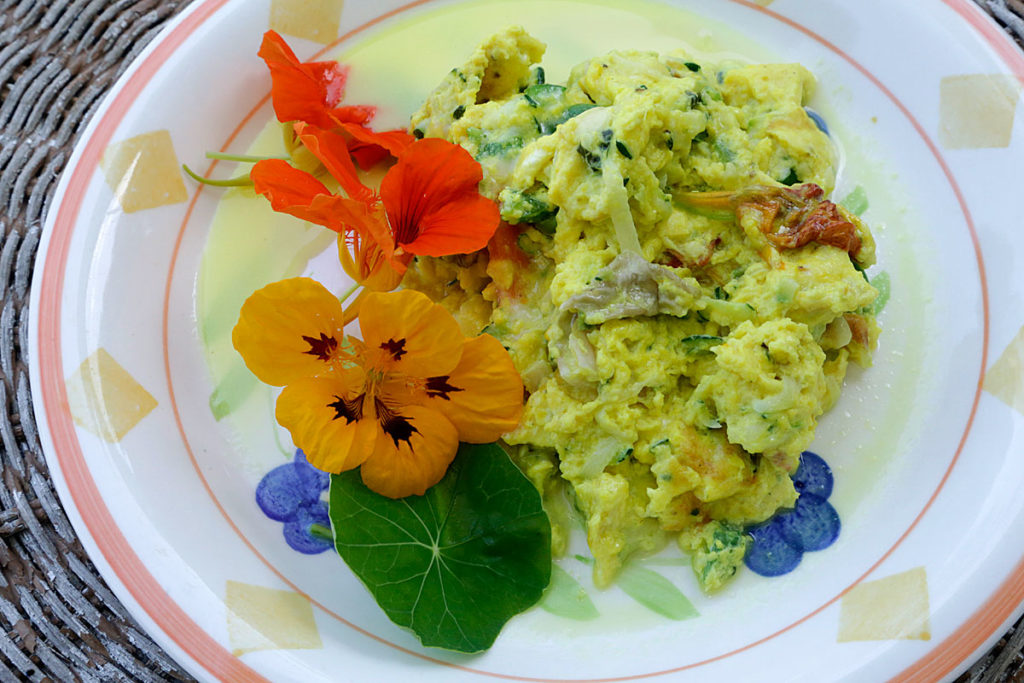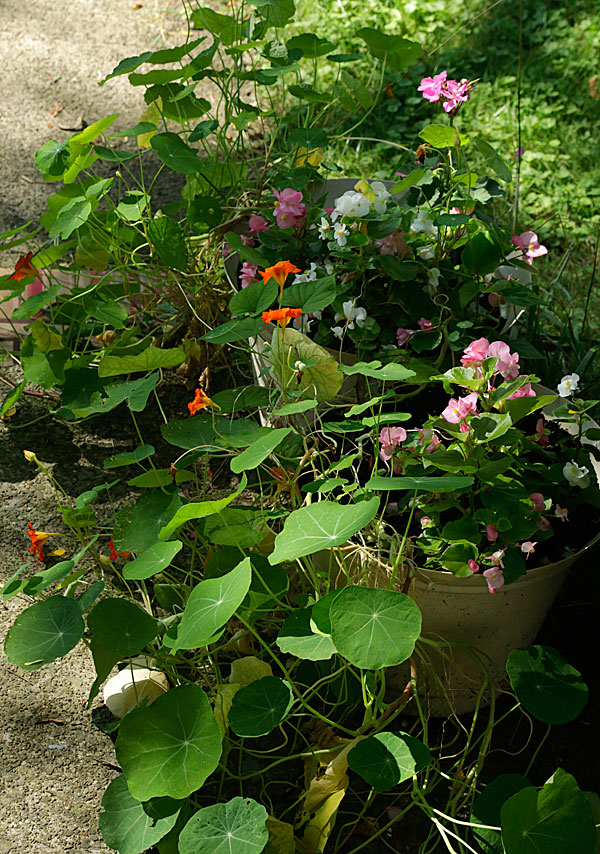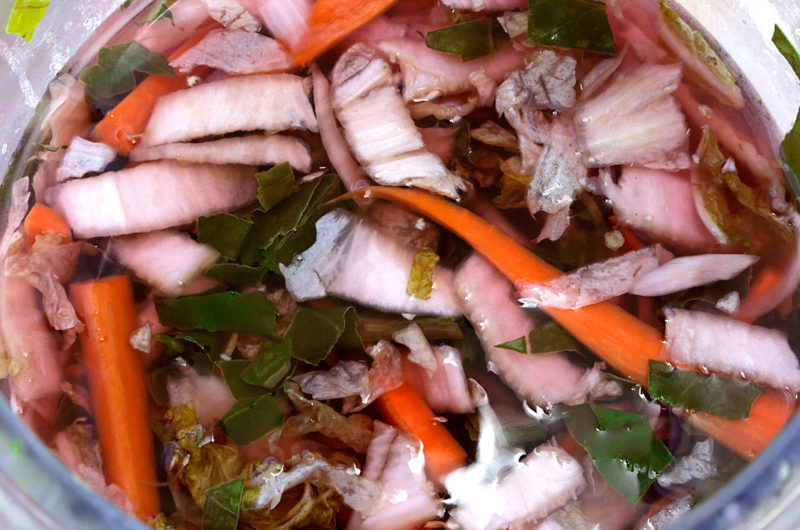Everyone loves potato salad, and summer is the season to enjoy it. It is a welcome recipe you can make ahead of time and pair it with another type of salad and some BBQ. Usually, some pickle is included in potato salad, giving an excellent crunchy taste. Pickles come in several styles. There is another way to give potato salad a little tangy and healthy twist.
In summer, when fresh vegetables are plentiful and in season, you may want to pay a visit to your local farm stand or farmers market and pick up some extra fresh veggies. Or, if you have a garden of your own, you may be looking for a way to preserve some of that bounty.
Pickling is a great way to save some types of produce. We all think of pickles, but you can add several pickled things to a potato salad. The pickling process involves making an acidic boiled brine and adding some spices. The cucumbers, beets, or other foods are placed in sterilized bottles of brine and left to cure for several weeks. Pickling can also make things softer rather than crunchier.
There is another way to preserve cucumbers and many other vegetables. It is called Fermentation. This process has no acidic additives like vinegar but produces its characteristic sourness using the lactic acids in the vegetables themselves. The brine is a salt-based preservative. You must use salt that does not have iodine added. Plain sea salt, pickling salt, and Himalayan Sea Salt are some types that can be used.
Fermenting Foods is easy when you follow a few basic rules.
- Sterilize the glass jars before using them. You can briefly rinse the bottles with boiling water, place them in a canning pot, and bring them to a boil, or heat them in a 275F oven for 15 minutes.
- Boil the water and add the salt to dissolve it completely, then let it cool to room temperature before adding it to the vegetables.
- The amount of salt needed is about two tablespoons per quart. You can add up to 3 tablespoons.
- Use only non-iodized salt such as plain sea salt, pickling salt, or Himalayan Sea Salt.
- Always use the freshest veggies you can.
- Add other spices as desired.
- During fermentation, the fragrance of the fermenting vegetables should be sweet and appetizing. Discard any rotten-smelling ferment.
- Once fermented, the jars must be capped and stored in the refrigerator. They will last for 3 or 4 months and crease in flavor. When they near the end of their freshest taste, they are still good to add to cooked dishes and impart a unique flavor.
- Use plastic, Silicone, or boiled wooden utensils for stirring and serving; don’t use metal utensils.
Kimchi is a fermented condiment made for hundreds of years in Korea.
There are several types of Kimchi. It is said to be one of the most lactobacillus-rich fermented foods you can eat. Sauerkraut is a close second. One thing that gives Kimchi its characteristic taste is the spices and other ingredients used.
Making your own Kimchi is not as hard as it looks. Although all the ingredients were unavailable where I live, I made Kimchi with a few substitutions last fall, and it was delicious.
Fermented foods can be eaten as a condiment or side dish to any meal. They are very beneficial to our gut health. One thing I like to do is add a small amount of fermented vegetables to salads and stir-fries instead of salt. They add nutrition with a delicious crunch. Fermented foods stay firm when added to stir-fries no matter how long you cook them.
When you eat Fermented Vegetables, you enrich your diet with probiotic bacteria, lactobacillus, and enzymes. These add to intestinal flora and fauna and increase the health of our gut microbiome. They also work to increase the immune system.
Helping you make Fermented vegetables is fun for kids to do, too. Children can get involved in cutting vegetables. Watching the bubbles as Fermentation takes place is also a lot of fun. Within less than a week, your fermented vegetables are ready to eat. Getting used to healthy foods as a child means they develop a taste for good things that will benefit their lives long-term.
The best time to make Kimchi, Sauerkraut, or other fermented vegetables is when the ingredients are plentiful in the fall. They can be kept in the fridge almost all winter long and perk up the flavors in many meals. Nowadays, it is easier to include fresh vegetables in your diet all year round. But occasionally, we get into the habit of only using frozen or tinned. Work and busy lives are made easier. A fermented vegetable or two stored in your fridge adds to the taste, speed of prep., and healthful meals.
There is a way to preserve Kimchi and Sauerkraut in a non-refrigerated method by sealing them tightly and storing them in a cool place. I have not done this and prefer to make just what can be kept in my fridge.
In the earliest part of summer, when the veggies are just beginning, blending various vegetables and fermenting them to use in summer salads is fun. And there you have it, my New Twist on Summer Potato Salad.
Fermented Vegetables and Potato Salad Recipe
Fermented Vegetable Medley
Course: CondimentsDifficulty: Easy1
hourFermentation of a Vegetable Medley is easy with store-bought ingredients.
Ingredients
1 small head of green or curly cabbage cut into small chunks
2 sweet red peppers with seeds removed and sliced
½ small jalapeno pepper (optional)
2 large red onions, sliced
1 bunch of red radishes, sliced
3 or 4 kale leaves washed and stems removed – chopped
2 carrots, thickly julienned
1 medium-sized beet, peeled and julienned
3 garlic cloves grated
One tablespoon of fresh ginger grated
Directions
- Prepare ahead:
One large glass cookie jar with a glass lid (or large pickle jar) Or two wide-mouth” Ball or Mason” jars. There are also large jars particularly made for fermenting.
Sterilize the jar by placing a fork in it so it won’t break and pouring boiling water inside. The water will be a bit too hot to handle, so let it cool and pour the water out later. Or if you have a large jam pot, this can work. Also, make sure to sterilize the lids. - Prepare Brine:
1 or 2 quarts of boiling water (4 cups in a quart)
2 ½ tablespoons Pink Himalayan Sea Salt (adds minerals) or Pickling Salt (must not contain iodine) per quart of boiling water. Let the water cool to room temperature while you prepare the vegetables. - Cut up the cabbage, carrots, onions, and peppers. Coarsely chop the Kale leaves, and julienne the carrots and beet. Grate the garlic and ginger. Blend the vegetables in a bowl with your hands to combine well.
- Pack the jar or jars with veggies. Fill the jars only 3/4 full to allow for expansion as the fermentation process occurs. Pour in the brine to cover the vegetables. Put the lid on the jar; don’t tighten it all the way. Place plastic wrap between the lid and the jar if you use a large pickle jar. Put the jar on a plate, as it sometimes rises and can overflow somewhat as fermenting. Let sit at room temperature for 4 to 6 days. Take the lid off daily and push the vegetables down under the brine with a non-metallic utensil. The mixture will have a delightful sour fragrance. If it smells at all spoiled, throw it out. Watch the lactobacillus bubble slightly. It is fun to see.
- On the fourth day, remove a small amount of the ferment and taste it. If it is sour enough, refrigerate and use as needed as a condiment or flavor enhancer in cooking. Otherwise, you can let it continue fermenting for another day or so. When using fermented vegetables in a recipe, do not add any additional salt to your dish.
- Once the vegetables are fermented, place the jar in the refrigerator and use it as desired. You can vary the amount and size of the glass jar to suit your needs. The main thing to remember is the ratio of salt to the water.
Notes
- You can vary the amount and size of the glass jar to suit your needs. The main thing to remember is the ratio of salt to the water.
Summer Potato Salad with a Fermented Twist

ingredients to Make creamy potato Salad
7 or 8 good-sized potatoes boiled in their skins until soft
1/8 teaspoon black pepper
1 tablespoon prepared mustard
1/8th teaspoon nutmeg (a French Chef’s Secret)
2 tablespoons Avocado oil
¼ cup boiling water
¼ cup Fermented Vegetable juice with some of the vegetables as desired.
2 stalks of celery chopped
Chopped fresh green pepper and green onions
4 medium soft-boiled eggs
¼ cup mayonnaise
1/3 cup sour cream
Directions
- Scrub potato skins and cover with cold water in a saucepan. Bring to a boil, then simmer until soft. Let the potatoes cool enough to handle. Peel the potatoes or leave the skins on, as desired.
- Slice the potatoes into a bowl and add the black pepper, prepared mustard, nutmeg, Avocado oil, and boiling water. Toss gently to moisten the potatoes and let sit for five or ten minutes to allow the potatoes to soak up the liquid.
- Add the Fermented Vegetable juice with some of the vegetables as desired.
Add the chopped celery, medium-soft-boiled eggs, mayonnaise, and
sour cream. Toss again and refrigerate if not serving right away. Potato salad is delicious when freshly made. - Garnish Potato salad with Nasturtium flowers and leaves. They pack a nutritious punch.

Nasturtiums are fun and easy to grow in your garden or containers. Plant them in the early spring after any danger of frost has passed. Water as needed, and they will sprout in about two or three weeks. Once the warm weather comes in June, they will bloom and continue until a fall frost.
Nasturtiums come in colors from yellow and red to burgundy. Nasturtium flowers contain the highest percentage of Lutein of any vegetable. The leaves are just as nutritious as the flowers; both have a delicate, peppery flavor. Mix them with another salad if the taste is too strong for you. You can use larger leaves as a wrap. Although I have never eaten the roots, I understand they are also edible. Besides being good for you, they are a boon for the eyes as they add eye-helpful Lutein and a delightful splash of color to your breakfast or dinner plates.
Read more about Nasturtiums and Fermented Vegetables.
Have a look at Gluten-Free, You Can Do It – My latest cookbook is available now in both Hardcover and Kindle e-books.
I hope you enjoy this delicious potato salad!





Pingback: Fermented Foods For Taste And Nutrition – Astoria Magazine